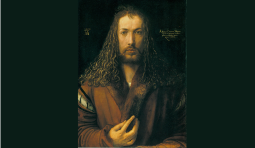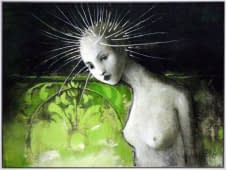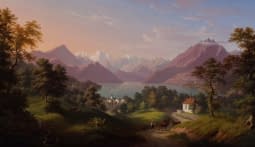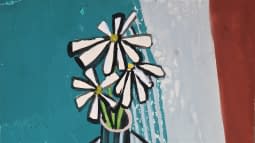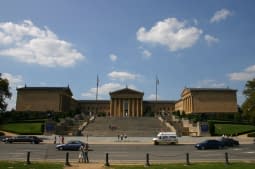Artists Influence Artists Part 2: From Paris to Berlin
While the first part presents examples of indirect influences, the second and third parts focus on the direct influences of artists. The two greatest artists who indirectly influenced the art of certain art24 artists are Pablo Picasso and Andy Warhol. A hundred years before Picasso and Warhol conquered the art world, «modern art» was still considered to be Impressionism, Art Nouveau and, in particular, Expressionism.
Cuno Amiet and Giovanni Giacometti
In Switzerland, the painters Cuno Amiet (1868-1961), Giovanni Giacometti (1868-1933) and Ferdinand Hodler (1853-1918) were among the most important pioneers of modernism. Amiet and Giacometti met for the first time in 1887. From October 1888 to May 1892, they lived and worked in a residential and studio community in Paris. Here they portrayed each other, were artistically very active and deepened their artist friendship. The two are said to have influenced each other's art until 1920.
The video of the Schweizer Film Wochenschau for the double exhibition at that time on the occasion of the 100th birthday of both Swiss painters in the Berner Kunsthalle shows two portraits of the opposite person in their shared studio in Paris.

Other mutual portraits that were created during their stay and work in Paris are Giacometti's paintings «Cuno Amiet, playing the mandolin» (1890), «Amiet, reading, Paris» (1891) as well as Amiet's paintings «Giovanni Giacometti at the easel» (1889) and «Giovanno Giacometti reading at the window (Paris)» (1890).
The following picture shows a selection of works by Cuno Amiet that depict him painting or other portraits of artists. In the middle, for example, is a portrait of the French sculptress Germaine Richier (1902-1959), who was a fellow student of Alberto Giacometti (1901-1966), Giovanni Giacometti's son, in the studio of Émile-Antoine Bourdelle (1861-1929).
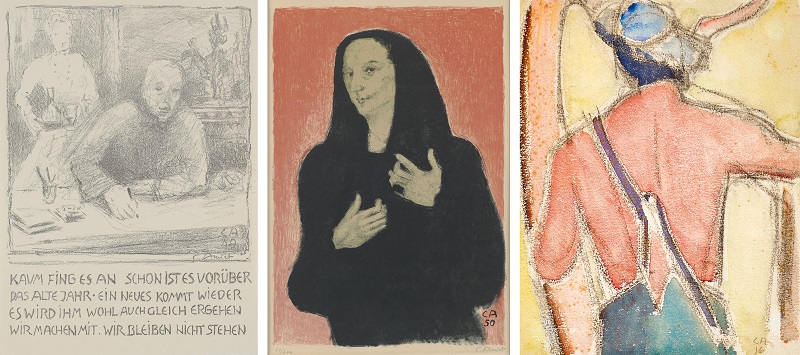
Erich Heckel and Ernst-Ludwig Kirchner
In the same period, completely different types of artistic communities were established in Germany. Artists such as Erich Heckel (1883-1970), Ernst-Ludwig Kirchner (1880-1938), Hermann Max Pechstein (1881-1955), Franz Marc (1880-1916), Emil Nolde (1867-1956) and Paul Klee (1879-1940) had a major influence on German Expressionism.
Heckel and Kirchner met as architecture students in Dresden in 1905. With other fellow students, Karl Schmidt-Rottluff (1884-1976) and Fritz Bleyl (1880-1966), they expressed their passion for art and founded the artists' association Brücke, which was later joined by other artists such as Amiet and Pechstein.
The goal was a new, younger, freer generation of artists who wanted to break with the old conventions and pursue a uniform style of painting. They worked together in the Brücke studio or outdoors in Dresden and had a considerable influence on the painting style of the other Brücke members. Five years after its foundation, in 1910, the group's artistic work flourished. They found a common style of art, which lay in the strong choice of colours, an energetic and quick brushstroke of the detail-free, slightly abstracted, angular execution. Artistically, they expressed themselves in lithography, watercolour painting or woodcut. In terms of motifs, people, the nude, the circus and varieté, nature and the city were chosen.
The friendship between Heckel, Kirchner and Pechstein deepened. Together, but also individually, they travelled to Berlin, Hamburg or further north. In 1911, the Brücke artists moved to Berlin together. Gradually, the artists developed in other directions and the bond crumbled. In 1912, for example, Pechstein was excluded from the group because he did not want to take part in the exhibition of the «Neue Secession», an exhibition association founded by the Brücke members, but instead took part in the Berlin Secession. One year later, the Brücke dissolved due to disagreements within the group.
Kirchner, who wrote the text for the Brücke chronicle in 1913, is said to have distinguished himself as the leader of the group. The pride and arrogance of his artist friend, as well as the disappointment over the loss of this friendship, were processed by Heckel in his art. In 1917 he created the painting «Roquairol», based on the novel character by Jean Paul. Heckel is said to have seen Kirchner in her. Negative character traits such as jealousy, malice, brokenness, and betrayal are attributed to the novel character.
While the artists influenced each other in their friendly relationship, they also often exerted a lasting influence, whether positive or negative, on each other's painting after their time together.
References and links for further information:
- Brücke, 1910: Brücke-Museum | 1910: Brücke. Art and Life (bruecke-museum.de)
- Brücke, 1913: Brücke Museum | 1913: The Brücke and Berlin (bruecke-museum.de)
- Erich Heckel: Brücke Museum | Artists | Erich Heckel (bruecke-museum.de)
- Max Pechstein: The Bridge Museum | Artists | Max Pechstein (bruecke-museum.de)
- Ernst Ludwig Kirchner: Brücke-Museum | Artist | Ernst Ludwig Kirchner (bruecke-museum.de)
In the third blog part, "Artists Influence Artists Part 3: From Munich to Switzerland", further artists' friendships are presented who mutually benefited from their joint work. The journey ends in Switzerland.

